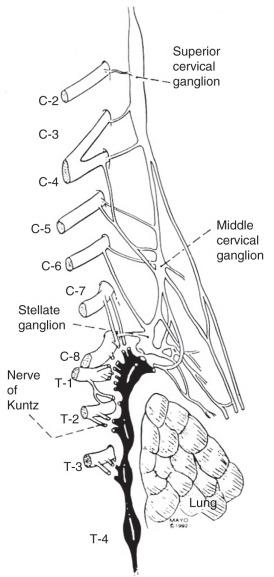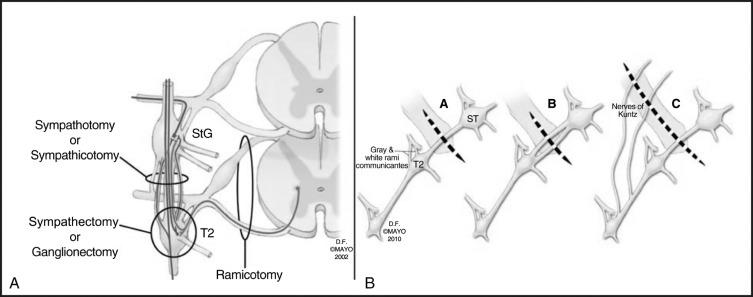Physical Address
304 North Cardinal St.
Dorchester Center, MA 02124
Minimally invasive endoscopic technology has rapidly transformed both thoracic and abdominal surgery, and the field of surgical sympathectomies is no exception. For thoracic sympathectomy, the thoracoscopic procedure is used almost exclusively. Laparoscopic and retroperitoneoscopic techniques have also been developed for ablation of the lumbar sympathetic chain. Because of its relatively less invasive nature, the open technique for lumbar sympathectomy is still performed, but with rapidly decreasing frequency. Indications for both thoracic and lumbar sympathectomies have changed over the past decades. Earlier indications such as claudication, uncomplicated primary Raynaud syndrome, or scleroderma are not used. Refractory palmar and plantar hyperhidrosis, chronic pain syndrome, Buerger disease, frostbite, and complicated primary Raynaud syndrome and secondary Raynaud phenomenon with nonhealing digital ulcerations have become the most common indications for endoscopic sympathectomy.
Although Jabouley suggested sympathetic denervation for vasospastic disorders as early as 1899, periarterial sympathectomy was introduced by Leriche only in 1913 for ischemic lesions caused by vasospasm. The first lumbar sympathectomy was performed by Royle in 1923 to treat a patient with spastic paralysis of the lower limb. The concept of sympathectomy was soon adopted by Adson and Brown, who performed lumbar sympathectomy to relieve vasospasm of the lower extremities. Adson and Brown were the first to perform cervicothoracic sympathectomy in 1929.
Using the single-scope technique, thoracoscopic sympathectomy was popularized by Kux in Austria as early as 1954. With the advent of endoscopic surgery, both thoracoscopic and laparoscopic or retroperitoneoscopic procedures have been developed for sympathetic denervation.
The peripheral nervous system includes both somatic and autonomic components. The somatic efferent motor nerves control the voluntary striate muscles and the afferent nerves transmit somatosensory information to the brain. The autonomic nervous system transmits information from the abdominal viscera as well as the smooth and cardiac muscles and the exocrine glands. Autonomic nerves are composed of the sympathetic and parasympathetic nervous systems.
The sympathetic nervous system consists of the central autonomic network—which includes the brain stem, diencephalons, and cortex—and the peripheral sympathetic pathways. The peripheral sympathetic pathway consists of preganglionic and postganglionic neurons. Information from the brain stem and hypothalamus descends through the lateral funiculus of the spinal cord to the preganglionic sympathetic fibers. The preganglionic sympathetic neurons originate in the anteromedial column of the thoracolumbar cord, between T1 and L2. These myelinated white nerve fibers travel in the ventral root of the spinal cord to the paravertebral sympathetic ganglia, where they synapse onto the postganglionic unmyelinated gray fibers. It is likely that each preganglionic axon innervates about 10 postganglionic neurons. The postganglionic axons can leave the parasympathetic ganglia at the level of the synapse or can travel first up or down in the sympathetic chain before exiting the ganglion via gray rami. The regional activity of the sympathetic chain is the product of reflex arcs between somatic afferent fibers and preganglionic efferent fibers. For sympathetic denervation of the upper limbs, interruption of the sympathetic chain from T2 to T4 is required. Although the stellate ganglion has some innervation to the upper limbs, resection of the stellate ganglion results in Horner syndrome (ptosis, myosis, and enophthalmos). Because of this associated morbidity, the stellate ganglion is not removed surgically. The nerves of Kuntz ( Fig. 32.1 ) are important because they provide direct collaterals from the T2 and T3 ganglia to the upper limbs. Resection of T2 and T3 ganglia (sympathectomy) is thought to be essential to achieve good and durable sympathetic denervation of the arms. The preganglionic fibers may bypass the paravertebral ganglia to synapse with more distal intermediate ganglia or may cross over to innervate the contralateral side as well. Therefore, as mentioned previously, a complete sympathectomy includes division of the preganglionic fibers and excision of the relay ganglia T2 and T3 and the intercommunicating fibers (the nerve of Kuntz). Several authors advocate T4 and T5 resection, especially in patients who undergo the operation for axillary hyperhidrosis.

Fig. 32.2 depicts the finer anatomy of the nerves and illustrates the difference between T2 sympathectomy and T1 to T2 sympathotomy at the level of the second rib. Atkinson and colleagues advocate performing sympathotomy by severing all visualized sympathetic branches between the T1 (and C8) ganglion and the T2 ganglion so as to minimize axonal and potential neuronal injury, which may increase side effects, particularly compensatory postsympathectomy hyperhidrosis.

In addition to the paravertebral ganglia, there is another subtype of peripheral sympathetic ganglia: the prevertebral ganglia. These include the celiac, aortorenal, and superior and inferior mesenteric ganglia located in the abdominal cavity, on the top of and around the aorta. These ganglia send postganglionic fibers to the abdominal and pelvic organs.
The sympathetic nervous system modifies basal organ functions and mediates the body's response to stress (“fright, flight, and fight response”). The primary function of the peripheral sympathetic nervous system is to prevent heat loss by reducing the blood flow to the skin and subcutaneous tissue of the limbs. The increased activity of the postganglionic sympathetic nerves, mediated by norepinephrine, results in decreased blood flow because of stimulation of the vasoconstrictor fibers innervating the blood vessels. There is increased sweating caused by stimulation of the sudomotor fibers innervating the exocrine glands (an activity mediated by acetylcholine, adenosine, and other neuropeptides) as well as piloerection mediated through the activity of the pilomotor fibers that innervate the erector pili muscles. The sympathetic system antagonizes the vasodilatory effect of the parasympathetic nerves on the arterial resistance vessels, the cutaneous precapillary sphincters, and the capacitance venules.
As a result of sympathetic denervation, the blood flow to the skin increases, there is a loss of sweating and piloerection, and the hands after thoracic sympathectomy/sympathotomy and the feet after lumbar sympathectomy become warm, pink, and dry. Sympathectomy also results in decreased pain in the ischemic limb, likely owing to an enhanced tolerance to pain stimuli. The pain tolerance is better because of decreased tissue concentration of norepinephrine and reduced spinal augmentation of pain transmission to cerebral centers.
The maximal effect of the sympathectomy/sympathotomy is immediate, although vasodilation will be less after 1 week because of compensatory mechanisms. Blood flow changes recorded at 6 months following sympathectomy are minimal because of incomplete denervation, regeneration of fibers, and hypersensitivity of the receptors to circulating catecholamines.
Several authors have investigated the effect of sympathectomy on blood flow of the limbs. Cronenwett and colleagues found no increase of nutrient capillary perfusion as a result of sympathectomy. Using intradermal xenon clearance, Moore and Hall observed increased flow to the cutaneous capillary circulation. Rutherford and Valenta failed to confirm increased muscle flow as a result of sympathectomy. Dalessandri and colleagues, however, described increased collateral circulation in patients who underwent sympathectomy.
It is evident that the effect of sympathectomy on cutaneous blood flow is transient, but this period may be sufficient to heal superficial ulcerations. The more lasting effects of sympathectomy are on sweating, abnormal vasomotor tone, and pain relief.
In an earlier study from the Mayo Clinic, Lowell and colleagues reviewed indications for cervicothoracic sympathectomy in 68 patients. The most frequent indications were atheroembolism followed by Raynaud syndrome, causalgia, hand ischemia, reflex sympathetic dystrophy, and Buerger disease. The most frequently used indications for thoracic sympathectomy are medically refractory palmar-plantar hyperhidrosis and causalgia. Additional indications include distal digital occlusion, vasospastic disorders with digital ulcerations not responding to medical treatment, Buerger disease, and frostbite. There is also a beneficial effect of sympathectomy on facial blushing. Uncomplicated Raynaud disease and scleroderma are contraindications to cervical sympathectomy ( Table 32.1 ).
| Indication | Thoracic Sympathectomy | Lumbar Sympathectomy |
|---|---|---|
| Best | Hyperhidrosis | Hyperhidrosis |
| Causalgia | Causalgia | |
| Frostbite | Frostbite | |
| Buerger disease | Buerger disease | |
| Raynaud phenomenon caused by stable arterial occlusions (e.g., traumatic subintimal fibrosis, distal emboli, digital gangrene) | Atheroembolism (blue toe syndrome) | |
| Facial blushing | ||
| Acceptable | Primary Raynaud syndrome with digital ulcerations or distal arterial occlusions | Inoperable Buerger or atherosclerotic arterial occlusions with limited tissue loss |
| Rest pain in nondiabetic patient owing to small arterial occlusions (e.g., distal Buerger atherosclerosis, arterial emboli) with or without Raynaud phenomenon | ||
| Contraindications | Uncomplicated Raynaud disease | Claudication |
| Diabetes with neuropathy |
Thoracic sympathectomy can be performed using open surgical technique, via transaxillary transthoracic approach or cervical approach, or using the thoracoscopic approach. Open techniques are rarely performed, usually only if thoracotomy or cervical incision is needed for another reason, such as vascular reconstruction or cervical or first rib resection.
Become a Clinical Tree membership for Full access and enjoy Unlimited articles
If you are a member. Log in here